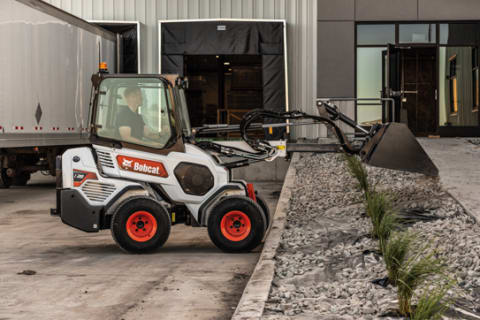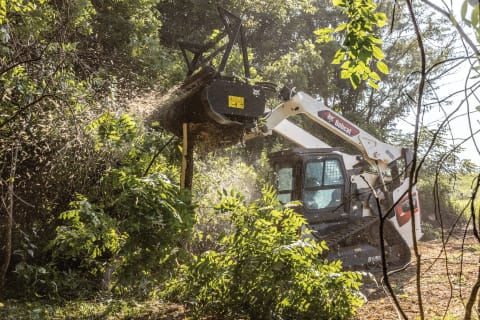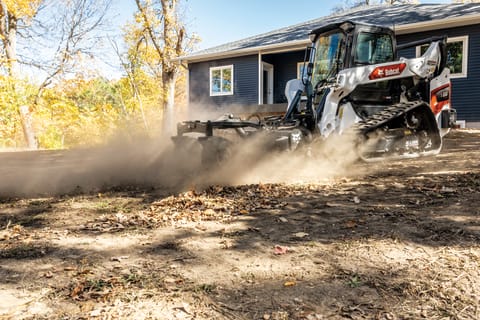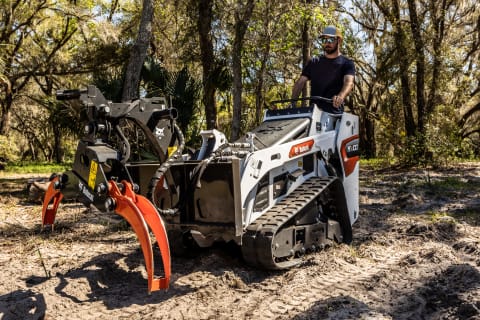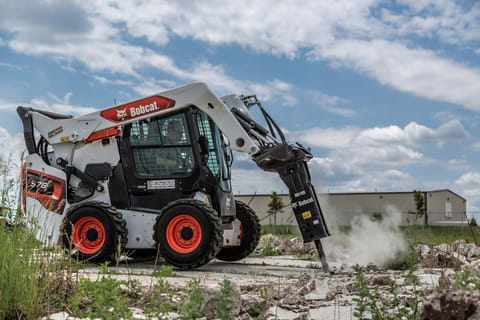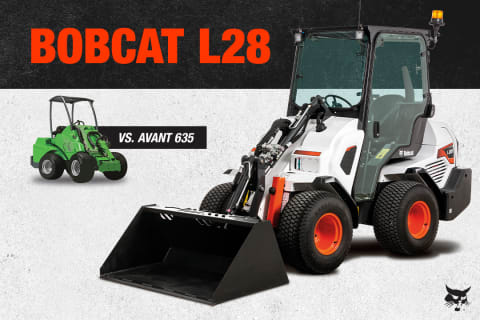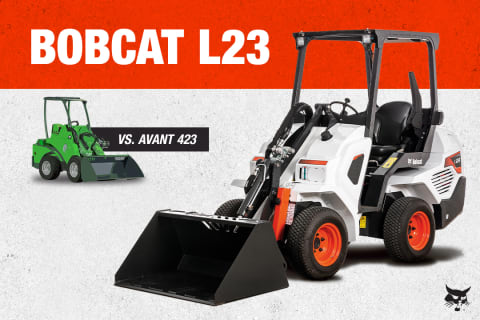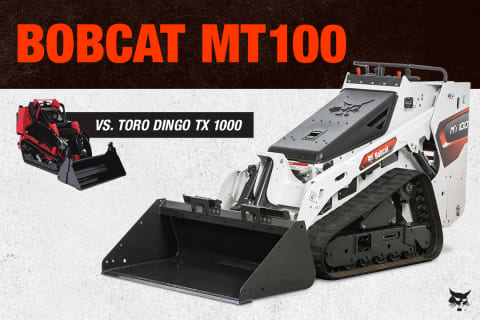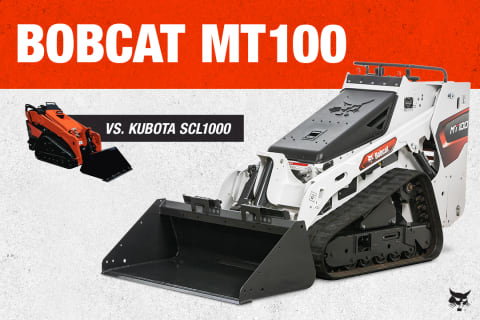- Home
- Buying Resources
- Loaders
- How to Tow a Bobcat Skid-Steer or Compact Track Loader
Build Your Loader, Get a Free Price Quote
Customize your loader. Select the model, choose options, and submit to your local dealer for a free price quote.
Build & QuoteHow to Tow a Bobcat Skid-Steer or Compact Track Loader
Posted on August 26, 2019
Properly transporting your Bobcat® skid-steer or compact track loader from one job to the next is important when considering the well-being of your crew and equipment. Help protect your people and your investment with these guidelines.
Summary
Your compact loader is used in a variety of applications with numerous attachments, which means you’ll likely be hauling your machine from jobsite to jobsite. But transporting your compact track loader or skid-steer loader involves several steps that shouldn’t be overlooked.
Follow these three hauling techniques and the recommendations in your Operation & Maintenance Manual to safely haul your equipment.
Selecting the Right Transport Vehicle
Before transporting your loader, make sure the transport or towing vehicle is of adequate size and capacity for the weight of the machine and attachments you’re transporting. A standard trailer is suitable for most loaders; however, if you are transporting oversized loads, you will likely need a larger trailer with a larger weight rating to handle the load.
Unsure of how much you can safely haul? A trailer or vehicle load rating can be found on its identification plate or in the owner’s manual.
All states and local municipalities have regulations based on gross vehicle weight rating. Load ratings vary in each state, so always check federal, state and local laws and regulations regarding weight, width, length and height of a load before transporting your machine. You may need special approvals or permits to transport oversized loads along your planned route.
Loading the Machine
Once you have identified the right transport vehicle, you can begin to load your equipment. First, to minimize the potential for any slipping, remove mud, sand and any other debris from your machine before loading it.
You should also follow these basic loading procedures:
- Check that the trailer is parked on firm and level ground.
- Secure the parking brakes and block the wheels of the transport vehicle.
- Use ramps that are the correct length and width and can support the weight of the machine.
- Use metal loading ramps with a slip-resistant surface.
- Disengage the auto-idle feature, and move the two-speed travel to the low-range position.
- Travel up the ramp with the heaviest end first when you are loading the equipment onto the trailer.
Tying Down the Skid-Steer or Compact Track Loader on the Trailer
Once your loader is on the trailer, lower the attachment to the floor of the trailer and stop the engine. Lock all doors and covers before transport.
Place chocks, cradles, wedges or other blocks in front of and behind each track or wheel to prevent rolling or shifting during transport. Then, install tie-downs at the front and rear Bobcat tie-down points as identified in your Operation & Maintenance Manual.
Most manufacturers recommend at least four tie-down positions to prevent any movement. Some transport devices have D-rings, chain slots or built-in strap rails that allow you to easily connect your machine to the trailer. Always use the recommended connection points and securements to minimize damage.
At this time also inspect the Bobcat tie-down points and tie-down equipment used to secure your machine. All pins and connection points should be secure and the hooks still functional. If you see any cracks, stretches or fatigued links, remove the tie-down equipment.
Whenever possible, connect the attachment to your loader before transport. If that isn’t possible, set the attachment on the trailer and secure it with chain straps. Always properly secure buckets and other attachments to the transport device.
If you use hydraulic attachments, make sure to route your loader’s hydraulic hoses in an orientation where they are not interfering with the machine on the trailer. For instance, hoses should not be lying underneath the machine, located in the way of a tie-down or connected where they could become disengaged.
Following these steps and all instructions in your Operation & Maintenance Manual will help minimize issues the next time you transport your equipment to a jobsite.
Get more information on manuals available for your specific machine, including loading information and machine specifications.
Explore More Loader Resources
View All Articles- Small Articulated Loaders Productivity for Grounds Maintenance
Small Articulated Loaders Productivity for Grounds Maintenance
Learn about how versatile and powerful small articulated loaders increase productivity and their advantages for ground-maintenance and landscaping professions. - How Compact Loaders are Beneficial for Forestry Work
How Compact Loaders are Beneficial for Forestry Work
Learn how Bobcat compact track loaders and skid-steer loaders provide versatility with attachments and machine power to increase your productivity for forestry work. - Landscaping Attachments for Compact Loaders
Landscaping Attachments for Compact Loaders
Explore the top landscaping attachments for your compact loaders, like compact track loaders for versatile productivity and power on the job. - Top Attachments for Mini Track Loaders
Top Attachments for Mini Track Loaders
Discover the top attachments from the 24 available for the Bobcat Mini Track Loaders for job-specific landscaping, grounds maintenance and forestry challenges. - Bobcat Attachments for Concrete Work with Compact Loaders
Bobcat Attachments for Concrete Work with Compact Loaders
Learn why Bobcat loaders are the machines of choice for concrete contractors with the productivity increase of Bobcat attachments specifically for concrete work. - How to Choose Compact Track Loader Tracks
How to Choose Compact Track Loader Tracks
The right compact track loader tracks can improve your machine’s performance, minimize ground disturbance and extend your working season in wetter months. - Bobcat L28 vs. Avant 635 Small Articulated Loader
Bobcat L28 vs. Avant 635 Small Articulated Loader
Small articulated loaders provide impressive lifting capabilities. When looking at the Bobcat L28 compared to the Avant 635, here are some factors to consider. - Bobcat L23 vs. Avant 423 Small Articulated Loaders
Bobcat L23 vs. Avant 423 Small Articulated Loaders
When choosing a small articulated loader, it can be overwhelming from the options. Explore this comparison of two popular options: the Bobcat L23 and Avant 423. - Bobcat MT100 vs. Toro Dingo TX 1000
Bobcat MT100 vs. Toro Dingo TX 1000
When choosing a mini track loader, it is important to examine key features and benefits. Explore how the Bobcat MT100 stacks up against the Toro Dingo TX 1000. - Bobcat MT100 vs Kubota SCL1000
Bobcat MT100 vs Kubota SCL1000
Every feature and specification matters, to obtain maximum production and output from a mini track loader. Compare the Bobcat MT100 against the Kubota SCL 1000.
